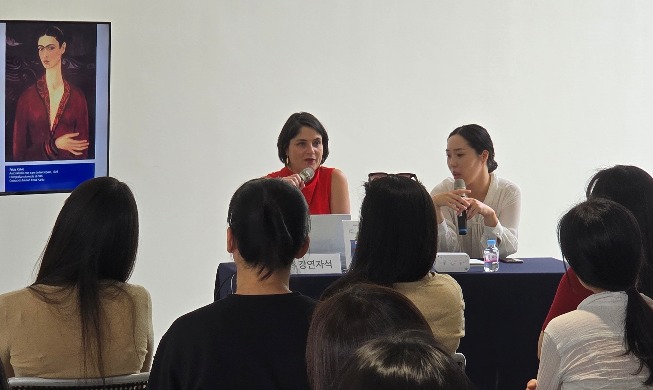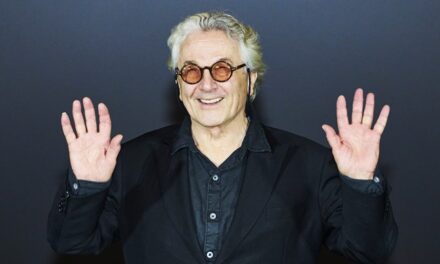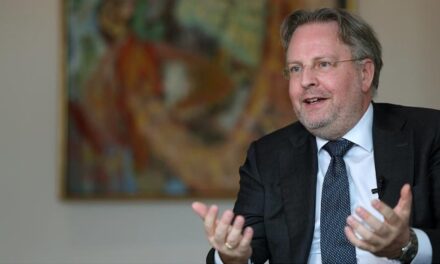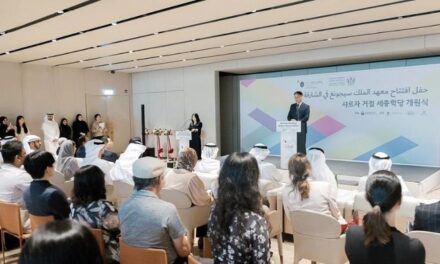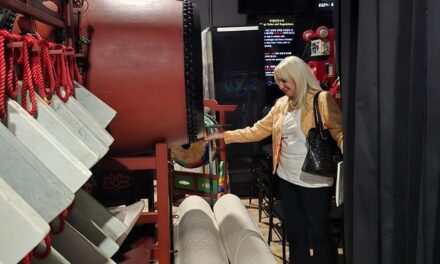So far, more than 200 officials from cultural and arts institutions worldwide have visited Korea through the program to discover and promote exchange and joint projects with domestic entities and experts. This year, 15 such figures from 15 countries recommended by Korean Cultural Centers abroad will visit in order.
Perla Labarthe Alvarez, director of the Frida Kahlo Museum in Mexico, visited Korea from June 4-10. Shown is Alvarez taking a photo with Kim Jae-hyun, director-general of the Ministry of Culture, Sports and Tourism’s International Cultural Affairs Bureau, after their meeting on June 7 at the conference facility Dalgaebi in Seoul’s Jung-gu District.
By Kim Hyelin
Perla Labarthe Alvarez, director of Museo Frida Kahlo, aka the Frida Kahlo Museum of Mexico, on June 4 arrived in Korea for a seven-day stay to explore the nation’s contemporary art, women and museums.
Her schedule included talks with domestic art figures including one with the chairman of the Galleries Association of Korea, a lecture given to curators of the National Museum of Modern and Contemporary Art, Korea, and visit to the studio of artist Yun Suknam.
Alvarez also visited cultural and arts institutions like National Jeongdong Theater and National Museum of Korea and historical sites such as Deoksugung Palace and Seokguram Grotto to explore all possibilities of bilateral exchange through art.
Saying she had high expectations in Korea since it was the first Asian country she visited, the director said with a big smile, “The visit program was surprisingly systematic, and everyone I met were friendly so my entire schedule went smoothly.”
An expert in design and museology, Alvarez in 2017 was named general coordinator of the museum and began serving as director last year.
Korea.net on June 7 interviewed Alvarez at KOCIS (Korean Culture and Information Service) Center in Seoul’s Jung-gu district on the arts of Kahlo and Korea. The following are excerpts from the interview.
What is the perception of Korea in Mexico?
The number of people interested in Korea is rising. Most Korean restaurants are concentrated in the Zona Rosa area in the heart of Mexico City. More Korean restaurants have recently opened in areas such as La Condesa, Colonia Roma and Colonia Juarez, and the number of visitors to them has risen.
I think the active operation of the Korean Cultural Center (KCC) in Mexico has greatly helped raise demand for Korean culture in Mexico. The number of Korean immigrants to Mexico has also risen. I think mutual interest is growing.
Briefly introduce the Frida Kahlo Museum.
Known as La Casa Azul (Blue House), the museum is where Frida Kahlo spent 36 of her 47 years (1907-54) of life. It’s said to be a space that reflects her essence. She initially lived there with her parents and sisters, and later with her lifelong partner Diego Rivera. Not only was it her home where Kahlo felt safe and comfortable, but also her creative space and workplace.
Visiting the space where an artist created works and lived allows us to look at her from a more intimate perspective.
Understanding Kahlo’s daily life by exploring the objects surrounding her and the environment that inspired her offers a unique window into her inner world and creative process.
The museum staff and I all share the privilege of working to preserve Kahlo’s legacy. But above all, I consider it an honor to share that legacy with the public.
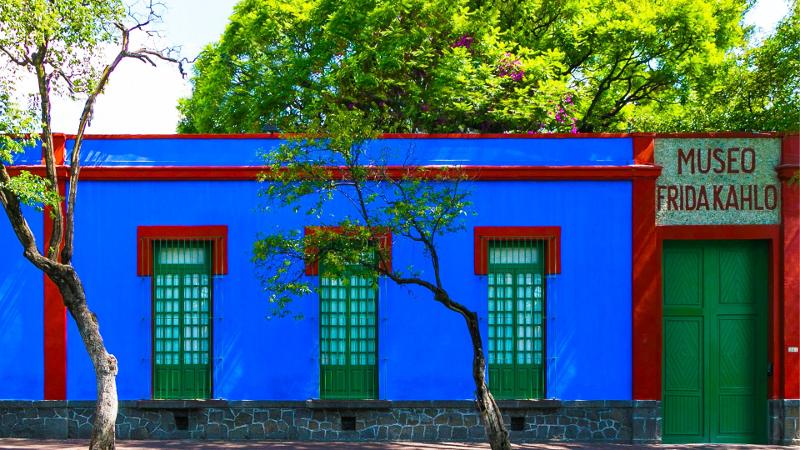
The entrance to the Frida Kahlo Museum is located in the Coyoacan borough of Mexico City. (Museum’s official website)
Which of Kahlo’s works is especially important or meaningful to you and why?
It’s hard to pick a few from the many, but the one that resonates most strongly with me is “Viva la Vida,” the watermleon still-life painting and her last signed work. Not only is the painting visually stunning, but it conveys well the messages of resilience and praise of life that often appears in Kahlo’s writings and art.
Kahlo’s collection should be viewed not only as paintings but also objects — books, brushes, paintings and the light coming through the studio window. The house is a living record of her life and work. I personally consider her bed important because she was confined to it after her tram accident at age 18 and started to paint, and this reflects a deep story about her life and self-expression process during her recovery period.
How do you want museum visitors to understand and experience Kahlo’s works?
Basically, I hope that everyone understands and experiences her work in their own ways. But if I had to answer, I think they can first enjoy the paintings to understand the artist, then focus on the aspects that resonate with them. Next, an interesting approach is to examine the texts and letters that provide deep insight into Kahlo’s thoughts and creative process.
I believe that understanding Kahlo is inseparable from exploring the space at La Casa Azul. Her entire surrounding environment became an essential part of her world of art through details such as the plants in the garden and pets.
You can also feel at this place traditional elements of Mexico in a variety of ways. I hope La Casa Azul becomes a channel through which visitors not only enjoy Kahlo’s art but also all of Mexico.
What is your impression of Korean art and culture?
The impression I’ve gotten so far is surprise. I was completely captivated by the ways tradition and modernity coexist in harmony. Both aspects seem contradictory but naturally form a harmony in Korean cities and at museums and art galleries. This is similar to how La Casa Azul not only preserves the personal histories of Kahlo and her partner Diego Rivera, but also reflects the overall lives of Mexicans in the first half of the 20th century.
Artists such as Kahlo and Rivera continuously explored the Mexican identity and cultural values in their works after the Mexican Revolution (1910). I think Korea’s ways of harmonizing tradition and modernity is also an exploration of identity.
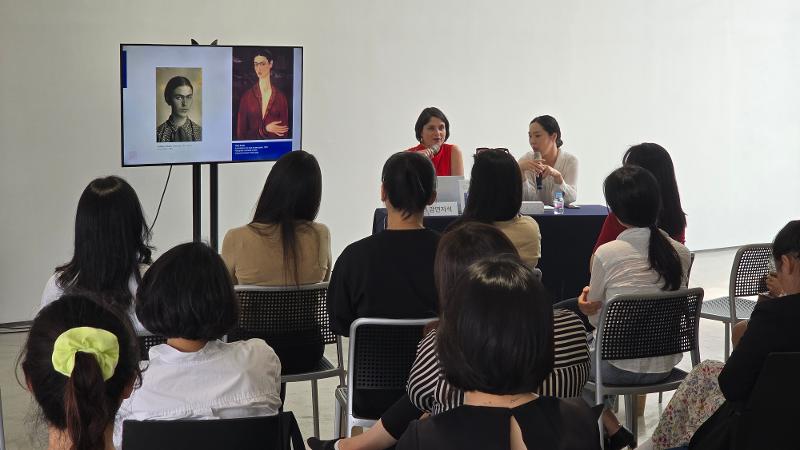
Frida Kahlo Museum Director Perla Labarthe Alvarez on June 5 gives a lecture to curators at the National Museum of Modern and Contemporary Art, Korea in Seoul’s Jongno-gu District. (Ministry of Culture, Sports and Tourism)
What did you most look forward to on your visit and what impressed you most?
I was most excited about visiting cultural institutions in Korea and meeting workers there. In the end, this was the activity that impressed me the most and was crucial for forming an interpersonal network and seeking opportunities for cooperation between arts and museum figures of both countries.
Giving a lecture on my second day to curators at the National Museum of Modern and Contemporary Art, Korea was very enriching. I explained how we improved La Casa Azul’s visitor education program to enable learning, reflection and fun, after which I talked to the curators about each of their experiences.
How can Korea and Mexico conduct exchange via museums and the arts?
Through this visit, I again realized how many opportunities there are for Korea and Mexico to cooperate in arts. La Casa Azul not only represents Kahlo’s life but is also where tradition and modernity merge just like in Korea. Through exchange and cooperation between institutions such as the KCC in Mexico City and La Casa Azul, I believe we can expand mutual understanding and acknowledge our similarities and differences in the arts.
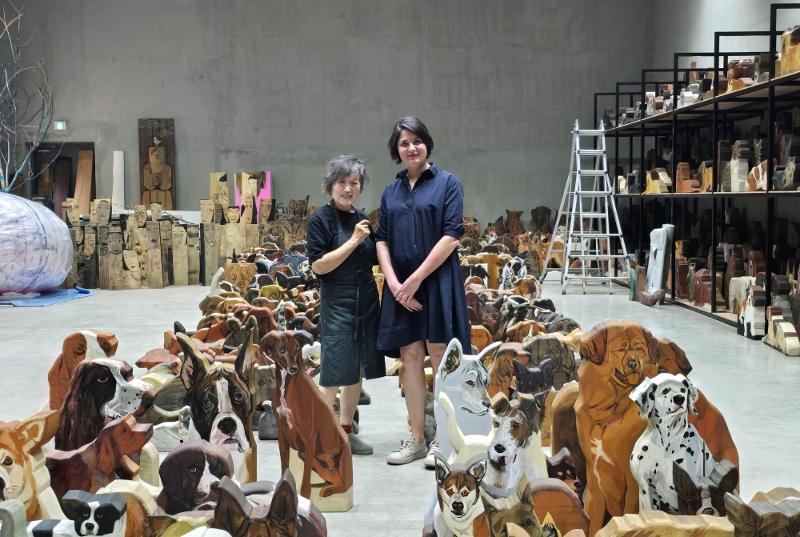
Frida Kahlo Museum Director Perla Labarthe Alvarez (right) on June 6 takes a photo with artist Yun Suknam at the latter’s studio in Hwaseong, Gyeonggi-do Province. (Ministry of Culture, Sports and Tourism)
What about Korean artists or art specifically interests you?
I still have so much to learn. When I saw the embroidery exhibition at the National Museum of Modern and Contemporary Art, Deoksugung, I realized how outstanding the displayed works, museology and preservation process all were. I also visited sculptor Yun Suknam’s studio to learn about her creative process, particularly her exploration of universal themes that transcend arts around the world.
What message do you have for young Korean artists and Korea.net readers?
Art has the power to connect us with ourselves, the people we love and those around us. To young artists, I ask them not to forget that the sensitivity and artistic creativity that museums strive to cultivate can be found in all aspects of daily life. To Korea.net readers, I want to say you’re always welcome at the Frida Kahlo Museum.
kimhyelin211@korea.kr

